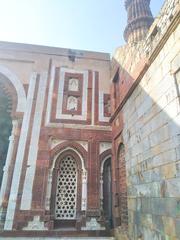
Guide to Visiting Yog Maya Mandir, Mehrauli, Faridabad, India
Publication Date: 31/07/2024
Introduction to Yog Maya Mandir
Nestled in the heart of Mehrauli, Delhi, the Yogmaya Temple, also known as Yog Maya Mandir, stands as a testament to India’s rich cultural and historical tapestry. This revered temple is dedicated to Yogmaya, a divine figure in Hindu mythology believed to be a reincarnation of Lord Vishnu and the sister of Lord Krishna. The temple’s origins trace back to the Mahabharata period, making it one of the oldest surviving temples in Delhi, with an estimated age of around 5,000 years (Hindustan Times). Over centuries, it has withstood numerous attempts at destruction, including those during the reign of Mahmud of Ghazni and Emperor Aurangzeb. Despite these challenges, the temple has evolved architecturally, reflecting a blend of ancient and medieval styles with its red stone construction now replaced by marble (Hindustan Times).
The Yogmaya Temple is not only a historical monument but also a vibrant center of cultural and religious activities. It celebrates numerous festivals, including the unique ‘Phoolwalon ki Sair,’ which symbolizes communal harmony by involving both Hindu and Muslim communities in floral offerings (Hindustan Times). Today, the temple continues to attract devotees and tourists alike, offering a serene and spiritually enriching experience. This guide provides comprehensive information on visiting hours, ticket details, historical significance, travel tips, and nearby attractions to ensure a memorable visit to the Yogmaya Temple.
Contents Overview
- Introduction
- History of Yogmaya Temple, Mehrauli
- Mythological Origins
- Historical Significance
- Medieval Challenges
- Architectural Evolution
- Cultural and Religious Significance
- Religious Practices
- Festivals and Celebrations
- Modern-Day Relevance
- Visitor Information
- Visiting Hours and Tickets
- Travel Tips
- Nearby Attractions
- Preservation and Management
- FAQ
- Conclusion
History of Yogmaya Temple, Mehrauli
Mythological Origins
The Yogmaya Temple, located in Mehrauli, Delhi, is steeped in rich mythological history. According to Hindu mythology, Yogmaya, also known as Jogmaya, is considered a divine illusion and is worshipped as the mother of all beings. She is believed to be a reincarnation of Lord Vishnu and the sister of Lord Krishna. The legend narrates that Yogmaya was born to Yashodha, the foster mother of Krishna, on the instructions of Lord Krishna. When Vasudeva, Krishna’s father, exchanged Krishna with Yogmaya to protect him from the tyrant Kansa, Yogmaya slipped out of Kansa’s hands and left her Pindi (a sacred stone) on a hillock near Delhi, which is now worshipped in the Yogmaya Temple (Hindustan Times).
Historical Significance
The Yogmaya Temple is believed to be one of the few surviving temples from the Mahabharata period, constructed by the Pandavas after the great war. This makes it one of the oldest temples in Delhi, with an estimated age of around 5,000 years. Despite its ancient origins, the temple has withstood numerous attempts at destruction and damage over the centuries (Hindustan Times).
Medieval Challenges
During the medieval period, the temple faced significant threats. One notable instance was during the reign of Mahmud of Ghazni, a Persian ruler from 970 A.D., who attempted to destroy the temple. However, the temple managed to survive these attacks. Another significant threat came during the Mughal era when Emperor Aurangzeb tried to convert the temple into a mosque. According to local lore, the laborers hired for this task mysteriously injured themselves, and any work done during the day would vanish by night. This led Aurangzeb to abandon his plans and instead offer a ‘Chattar’ (canopy) to the deity as an apology (Hindustan Times).
Architectural Evolution
The temple’s architecture has evolved over the centuries. The sanctum of Goddess Yogmaya is adorned with a 42-feet Vimanam (temple tower) and enclosed with a dome. The temple complex originally featured red stone construction, which has since been replaced with marble. The complex also boasts around twenty-two towers, adding to its grandeur. The deity Yogmaya, also known as the ‘Pure Goddess,’ is represented by a black stone idol placed in a marble well, 2 feet wide and 1 foot deep (Hindustan Times).
Cultural and Religious Significance
Religious Practices
The Yogmaya Temple is not just a historical monument but also a vibrant center of cultural and religious activities. It celebrates numerous festivals throughout the year with great enthusiasm. One of the most unique festivals celebrated here is the ‘Phoolwalon ki Sair,’ a seven-day event that symbolizes communal harmony. During this festival, Hindus offer a floral chaadar at the Dargah of Khwaja Bakhtiar Kaaki, and Muslims reciprocate by offering a floral chhatra at the Yogmaya Temple. This festival is a testament to the temple’s role in promoting unity and national integration (Hindustan Times).
Festivals and Celebrations
The temple is a hub of activity during major Hindu festivals such as Diwali, Holi, and Janmashtami. Special prayers, bhajans (devotional songs), and cultural programs are organized, attracting thousands of devotees. The temple’s management also arranges community feasts (langars) during these festivals, fostering a sense of community and shared spirituality. The vibrant celebrations and the influx of devotees during these times underscore the temple’s cultural importance.
Modern-Day Relevance
Today, the Yogmaya Temple continues to be a significant religious site, attracting devotees from all over the country. The temple opens its doors at 5 am with the morning aarti and closes after the evening aarti at 7 pm. The deity is adorned with flowers before each aarti, and the temple is filled with devotees during these times. Despite the hustle and bustle during the aarti, the temple remains a serene and peaceful place during the day (Hindustan Times).
Visitor Information
Visiting Hours and Tickets
The Yogmaya Temple is open daily from 5 am to 7 pm. Entry to the temple is free, allowing everyone to experience its spiritual ambiance without any cost.
Travel Tips
The temple is easily accessible by road and is a short walk from the Qutub Minar metro station. It is advisable to visit early in the morning or late in the evening to avoid the crowd and experience the temple’s tranquility.
Nearby Attractions
While visiting the Yogmaya Temple, you can also explore nearby historical sites such as the Qutub Minar, Mehrauli Archaeological Park, and the Dargah of Khwaja Bakhtiar Kaaki. These sites offer a deeper insight into the rich heritage of Delhi.
Preservation and Management
The temple’s preservation and daily operations are managed by the Vats family, who have been the custodians for generations. The current head of the temple is Vinod Vats, who continues the legacy of maintaining the temple’s sanctity and ensuring that the rituals are performed with utmost devotion. The temple’s head pujari, Kuldeep Mishra, plays a crucial role in conducting the daily rituals and overseeing the temple’s activities (Hindustan Times).
FAQ
Q: What are the visiting hours of Yogmaya Temple?
A: The temple is open daily from 5 am to 7 pm.
Q: Is there an entry fee for the temple?
A: No, entry to the temple is free.
Q: Are there any special events or festivals at the temple?
A: Yes, the temple celebrates numerous festivals, including the unique ‘Phoolwalon ki Sair’ which promotes communal harmony.
Q: What are some nearby attractions?
A: Nearby attractions include the Qutub Minar, Mehrauli Archaeological Park, and the Dargah of Khwaja Bakhtiar Kaaki.
Conclusion
The Yogmaya Temple stands as a testament to India’s rich cultural and religious heritage. Its historical significance, coupled with its role in promoting communal harmony, makes it a must-visit for anyone interested in exploring the spiritual and cultural fabric of India. The temple’s resilience through centuries of challenges and its continued relevance in modern times highlight its enduring legacy.
Call to Action
Plan your visit to the Yogmaya Temple and explore the rich heritage of Delhi. Don’t forget to share your experience and follow us on social media for more updates on historical sites and cultural events in India.
Summary and Key Points
The Yogmaya Temple in Mehrauli, Delhi, is a remarkable testament to India’s enduring cultural and historical heritage. From its mythological origins linked to Lord Krishna to its survival through medieval challenges and architectural evolution, the temple stands as a resilient symbol of faith and unity. It continues to play a vital role in promoting communal harmony through festivals like ‘Phoolwalon ki Sair’ and remains a significant pilgrimage site for Hindus, especially during Navratri and other major festivals (Hindustan Times).
For visitors, the temple offers a serene and spiritually enriching experience with its daily rituals, architectural beauty, and cultural significance. Easily accessible by road and public transportation, it is a must-visit for anyone interested in exploring Delhi’s rich heritage. Nearby attractions like the Qutub Minar and Mehrauli Archaeological Park further enhance the visitor experience, providing a deeper insight into the historical and cultural fabric of the region (Inditales).
Plan your visit to the Yogmaya Temple to immerse yourself in its rich history and vibrant traditions. For more updates and detailed guides, be sure to download our mobile app Audiala, check out related posts, or follow us on social media.

